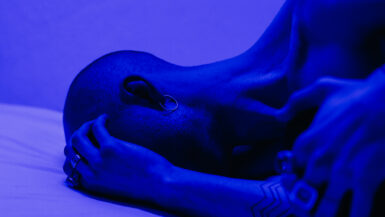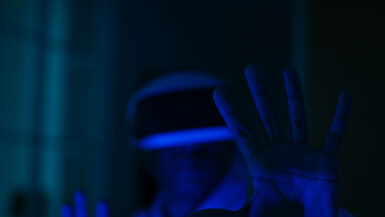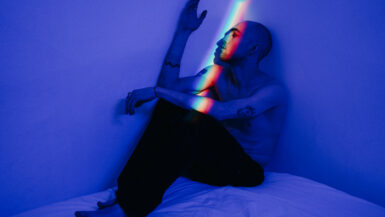In today’s technology-driven world, exposure to blue light has become an inevitable part of our daily lives. This high-energy visible light, emitted by smartphones, laptops, and other electronic devices, has been proven to have a significant impact on our sleep patterns and overall productivity. As we continue to rely heavily on these devices, it is essential to understand the consequences of excessive blue light exposure and learn effective strategies to minimize its harmful effects, particularly before bedtime. In this article, we will delve into the science behind blue light and its impact on our sleep and productivity, as well as provide practical tips on how to reduce exposure and optimize your sleep environment for a better night’s rest and improved daily performance.
Understanding Blue Light and Its Effects on Sleep
Before we dive into the various strategies to minimize blue light exposure before bedtime, it is essential to understand the science behind blue light and its impact on our sleep patterns. Blue light is a part of the visible light spectrum and has a wavelength of around 400-495 nm. While natural sources of blue light include sunlight, an increased amount of exposure comes from LED screens and electronic devices that we use daily.
The Connection between Blue Light and Circadian Rhythm
Our body has a natural 24-hour cycle, known as the circadian rhythm, which regulates various physiological processes, including sleep. One of the key factors influencing our circadian rhythm is light, particularly blue light. During daylight hours, exposure to blue light is beneficial as it helps maintain alertness and cognitive function. However, when exposed to blue light in the evening or at night, it can disrupt our sleep patterns by suppressing the production of melatonin, a hormone responsible for inducing sleep.
Impaired Sleep Quality and Insufficient Rest
Exposure to blue light before bedtime can lead to difficulty in falling asleep, frequent night-time awakenings, and overall reduced sleep quality. In turn, this can result in a lack of restorative sleep, which is crucial for our cognitive function, mood, and overall health. To learn more about how blue light affects our sleep and immune function, check out this article on How Blue Light Affects Sleep and Immune Function.
Reduced Productivity and Performance
Numerous studies have shown that poor sleep quality is linked to reduced productivity, impaired cognitive function, and increased risk of accidents. When our body doesn’t get enough rest, it becomes more challenging to stay focused and perform tasks efficiently, leading to decreased performance at work or school.
Now that we have a clear understanding of the effects of blue light on sleep, it is crucial to adopt effective strategies to minimize exposure, particularly during the evening hours. In the following sections, we will provide practical tips on how to reduce blue light exposure before bedtime and create a conducive sleep environment for a better night’s rest and improved daily performance.
Incorporating Blue Light Blocking Glasses
As we explore ways to minimize blue light exposure before bedtime, one effective solution is the use of blue light blocking glasses. These specially designed glasses are equipped with lenses that filter out a significant portion of blue light emitted by electronic devices, thereby reducing its impact on our sleep patterns. In this subsection, we will discuss the benefits of using blue light blocking glasses, how to select the right pair, and when to wear them for optimal results.
Benefits of Blue Light Blocking Glasses
Some of the primary advantages of incorporating blue light blocking glasses into your daily routine include:
1. Improved sleep quality: By filtering out blue light, these glasses can help regulate melatonin production, allowing you to fall asleep more easily and enjoy a more restorative night’s sleep.
2. Reduced eye strain and discomfort: Prolonged exposure to blue light can cause digital eye strain, which is associated with symptoms such as dryness, irritation, and fatigue. Wearing blue light blocking glasses can alleviate these symptoms and promote overall eye health.
3. Enhanced productivity: As a result of improved sleep quality and reduced eye strain, you may experience increased focus, better decision-making, and heightened creativity, all of which contribute to enhanced productivity.
Selecting the Right Pair of Blue Light Blocking Glasses
When choosing a pair of blue light blocking glasses, consider the following factors:
1. Lens color: Blue light blocking lenses come in various colors, ranging from clear to dark amber. While clear lenses may be more aesthetically appealing, darker lenses generally offer better blue light protection.
2. Lens quality: Look for glasses with lenses that block at least 90% of blue light in the 400-495 nm range. It is also essential to ensure that the lenses do not distort color perception or visual clarity.
3. Frame style and comfort: Choose a frame style that complements your face shape and provides a comfortable fit, as you may need to wear the glasses for extended periods.
When to Wear Blue Light Blocking Glasses
For optimal results, it is recommended to wear blue light blocking glasses during the following times:
1. Two to three hours before bedtime: Wearing the glasses during this timeframe can help regulate melatonin production and prepare your body for sleep.
2. While using electronic devices: If you spend long hours working on a computer, watching TV, or using your smartphone, wearing blue light blocking glasses can help reduce eye strain and improve overall visual comfort.
In summary, incorporating blue light blocking glasses into your daily routine can be an effective way to minimize blue light exposure before bedtime, leading to improved sleep quality, reduced eye strain, and enhanced productivity.
Choosing the Right Screen Filters and Apps
In addition to wearing blue light blocking glasses, another effective method to minimize blue light exposure before bedtime is by using screen filters and applications on your electronic devices. These filters and apps can help reduce the blue light emitted by your devices, making them less disruptive to your sleep patterns. In this subsection, we will discuss several popular screen filters and apps and provide guidance on how to choose the right ones for your needs.
Popular Screen Filters and Apps for Blue Light Reduction
There are various screen filters and apps available on the market designed to reduce blue light exposure from electronic devices. Some popular options include:
1. Physical screen filters: These are thin, transparent films that can be applied directly to your device’s screen, filtering out a significant portion of blue light emissions. They are available for various devices, including smartphones, tablets, and computer monitors.
2. Built-in blue light filters: Many modern electronic devices come with a built-in blue light filter, often referred to as “Night Shift” or “Night Mode.” This feature can be easily activated in your device’s settings and typically offers adjustable color temperature and scheduling options.
3. Third-party applications: Several apps, such as f.lux, Twilight, and Iris, can be installed on your devices to reduce blue light emissions automatically. These apps often provide a high degree of customization, including color temperature adjustments, scheduling, and app-specific filtering.
Factors to Consider When Choosing Screen Filters and Apps
As you explore the various screen filters and apps available for blue light reduction, keep the following factors in mind:
1. Compatibility: Ensure that the filter or app is compatible with your specific device and operating system. Some apps may only be available for certain platforms, while physical screen filters may require precise sizing for a proper fit.
2. Customization: Look for filters and apps that offer a high degree of customization, such as adjustable color temperature, scheduling options, and app-specific filtering. This will allow you to tailor the settings to your individual needs and preferences.
3. Ease of use: Choose a filter or app that is user-friendly and easy to install, configure, and adjust as needed. This will ensure that you can seamlessly integrate the blue light reduction solution into your daily routine.
4. Quality and effectiveness: Research the effectiveness of the filter or app in reducing blue light emissions. Reading user reviews and testimonials can provide valuable insights into the real-world performance of the solution.
To maximize the benefits of screen filters and apps, consider combining their use with other strategies, such as blue light blocking glasses and optimizing your sleep environment. By adopting a comprehensive approach to blue light reduction, you can significantly improve your sleep quality, enhance your productivity, and promote overall well-being.
Creating a Pre-Sleep Routine for Better Rest
Developing a consistent pre-sleep routine can contribute significantly to minimizing blue light exposure before bedtime, leading to improved sleep quality and overall well-being. A well-designed pre-sleep routine helps signal the body and mind that it’s time to wind down, making it easier to fall asleep and stay asleep throughout the night. In this subsection, we will discuss several key elements to consider when designing your pre-sleep routine and provide practical tips on how to implement them effectively.
Establish Consistent Sleep and Wake Times
One of the most important aspects of a pre-sleep routine is maintaining consistent sleep and wake times. Going to bed and waking up at the same time each day, even on weekends, helps regulate your body’s internal clock and promotes better sleep quality. Aim for 7-9 hours of sleep per night and adjust your bedtime accordingly to ensure you’re getting the rest your body needs.
Create a Relaxing Bedtime Ritual
Engaging in calming activities before bedtime can help your body and mind transition from the day’s stressors to a more relaxed state. Consider incorporating activities such as:
1. Reading a physical book: Opt for a printed book instead of an e-reader or tablet, as these devices emit blue light that can disrupt sleep.
2. Practicing meditation or deep breathing exercises: These techniques can help reduce anxiety and promote feelings of relaxation, making it easier to fall asleep.
3. Listening to calming music or white noise: Soothing sounds can create a peaceful atmosphere conducive to sleep.
4. Engaging in gentle stretching or yoga: Gentle movement can help release tension and relax the body.
Limit Screen Time and Optimize Your Sleep Environment
Reducing screen time before bed is crucial in minimizing blue light exposure and promoting better sleep. Aim to turn off all electronic devices at least one hour before bedtime and consider using an alarm clock instead of your smartphone to wake up. Additionally, creating a sleep-friendly environment can further enhance the quality of your rest. Consider the following tips:
1. Keep your bedroom cool, dark, and quiet: A cool temperature (around 60-67°F), blackout curtains, and a white noise machine can help create an optimal sleep environment.
2. Invest in a comfortable mattress and pillows: A supportive mattress and pillow can significantly impact your sleep quality.
3. Remove distractions: Keep your bedroom clutter-free and designate it as a space for sleep and relaxation, rather than work or entertainment.
Consider Light Snacks and Herbal Teas
While it’s best to avoid large meals close to bedtime, a light snack or a cup of herbal tea can help promote feelings of relaxation and satiety. Opt for foods that contain sleep-promoting nutrients, such as magnesium, tryptophan, and melatonin. Some examples include almonds, bananas, cherries, and whole-grain crackers. Herbal teas like chamomile, valerian root, and lavender can also help calm the mind and body, making it easier to fall asleep.
By implementing these tips and creating a personalized pre-sleep routine, you can effectively minimize blue light exposure, improve your sleep quality, and enhance your overall well-being. Remember that consistency is key – the more regularly you practice your pre-sleep routine, the more effective it will be in promoting restful, rejuvenating sleep.
Adjusting Device Settings for Nighttime Use
To minimize blue light exposure before bedtime, it is essential to adjust the settings on your electronic devices for nighttime use. Many smartphones, tablets, and computers come with built-in features that can help reduce blue light emissions during the evening hours, making it easier for you to wind down and prepare for a restful night’s sleep. In this subsection, we will explore some of these features, as well as provide guidance on how to customize your device settings to suit your individual needs and preferences.
Activating Built-In Blue Light Filters
Most modern electronic devices come equipped with a built-in blue light filter, often referred to as “Night Shift” or “Night Mode.” This feature adjusts the color temperature of your device’s screen, reducing the amount of blue light emitted and creating a warmer, more sleep-friendly display. To activate this feature, follow these general steps (specific instructions may vary depending on your device):
1. Navigate to your device’s settings menu.
2. Locate the display or screen settings section.
3. Find the option for Night Shift or Night Mode and enable it.
Customizing Blue Light Filter Settings
Once you have activated the built-in blue light filter on your device, you can further customize the settings to suit your needs and preferences. Consider the following adjustments:
1. Schedule: Set a specific time range for the blue light filter to activate automatically, such as from sunset to sunrise or during your preferred evening hours.
2. Color temperature: Adjust the warmth of the display to a level that is comfortable for your eyes without causing strain or discomfort. Note that warmer settings will generally provide better blue light reduction.
3. Screen brightness: Lowering the screen brightness during the evening can help reduce overall light exposure and make it easier for your eyes to adjust to a darker environment.
Utilizing Grayscale Mode
Another useful feature available on some devices is grayscale mode, which converts the screen’s display to shades of gray. This can help reduce visual stimulation and make it easier to wind down before bedtime. To activate grayscale mode, follow these general steps (specific instructions may vary depending on your device):
1. Navigate to your device’s settings menu.
2. Locate the display or accessibility settings section.
3. Find the option for grayscale or color filters and enable it.
Establishing Screen-Free Zones and Times
In addition to adjusting your device settings for nighttime use, consider creating screen-free zones and times in your home to further minimize blue light exposure before bedtime. This can help you establish boundaries between your digital life and your sleep routine, promoting better sleep hygiene and overall well-being. Some suggestions include:
1. Designate your bedroom as a screen-free zone: Keep electronic devices, such as smartphones, tablets, and laptops, out of your bedroom to create a sleep-friendly environment.
2. Establish a digital curfew: Set a specific time in the evening, such as one hour before bedtime, to power down all electronic devices and engage in screen-free activities to help you relax and unwind.
With these tips in mind, you can effectively adjust your device settings for nighttime use and establish healthy boundaries around screen time before bedtime. By doing so, you will not only minimize blue light exposure but also create a more conducive environment for restorative sleep and improved overall well-being.





Leave a reply